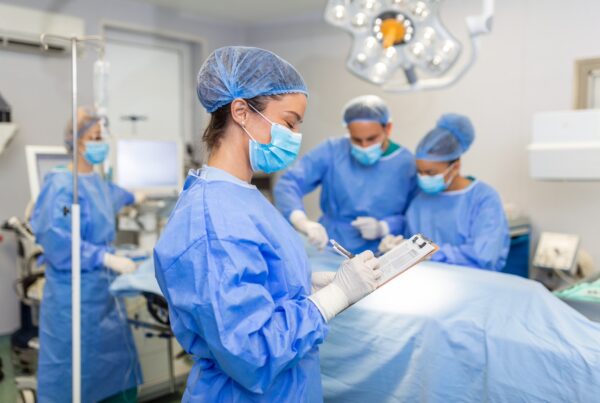How the Central Sterile Processing department is being left behind and the 4Ws to get in front of it.
It’s early morning time and everyone is preparing the patients for the first cases of the day. All the nurses, surgeons, and OR staff had their daily huddle yesterday afternoon to be prepared for successful first case starts (FCOTS). The first patient is prepped and ready for surgery. Vitals, labs, radiology results are ready, the anesthesiologist has met with the patient and the surgeon has done the site marking. The patient is an overall healthy individual and is just receiving a standard procedure. During the procedure, one of the instruments looked to be dirty so the OR staff put in a rush order for the sterile surgical instrument replacement. Due to the recent shortage of Central Sterile Processing Department (CSPD) techs the first case was delayed an hour. Despite the delay in the beginning, the surgery was a success and patient showed great signs of recovery. The next day the patient began to have a fever and later found out of it was due to an infection at the surgical site and now the hospital is facing scrutiny.
Does this situation sound plausible? Who is responsible for this surgical outcome? Where did the breakdown of communication start and where did the order of operations error occur? When you think of the surgery process you must consider each step and the individual involved. The lack of techs and involvement of a CSPD representative in the morning huddle is one of many variables that may have affected the hypothetical surgical outcome. Central sterile processing is a factor that many don’t consider to be a part of the “surgical” process but in fact, CSPD should be a factor and be held to a high standard.
Central Sterile processing handles all instruments for the operating room. The CSPD should be treated as an essential component of the OR, but in fact, in many cases CSPD is an afterthought. When the CSPD is functioning well, it plays an important role in clinical outcomes. When the CSPD is not functioning well, it can affect the OR negatively. Hospitals should investigate the current state of their CSPD and investigate who it affects, what is being affected, when errors happen, and why they happen.
Who is responsible for good surgical outcomes? Is it just the surgeon, nursing staff or anesthesiologist? Typically for the public, that would be the thinking. If the surgery is a “success” and the patient does well, all is good. But if the patient encounters an infection and needs additional medical care, the medical professionals and the hospital are at risk for a lawsuit. The question that remains is, does anyone think about the Sterile Processing Department and the current state that it is in? The answer is probably no. However, the time has come to be more aware of what the department provides and what it needs.
What are some of the factors that contribute to a struggling CSPD? In most instances, when prepping for a case, the surgical instruments are always already there. That is usually due to a high functioning CSPD. In today’s current state of healthcare, sterile processing is one of the areas of skilled labor taking a “hit”. With the many challenges CSPD is facing, hospitals are all suffering as they realize that there is a lack of CSPD leadership, and skilled technicians. Also, technicians are retiring or moving on to better paying jobs. When does the hospital investigate and consider the CSPD challenges are a priority in today’s current state?
When surgical cases are scheduled, an efficient operating room runs a daily huddle to make sure things are in order for the next day’s cases. The management team checks to be sure the patient is optimally ready for the surgical procedure, i.e.; lab and radiology results have been reviewed, an anesthesiologist has analyzed the patient’s record for anything out of the ordinary and the team makes sure the equipment is available. The sterile processing department manager or supervisor should always be present to assure the management team that all instruments will be prepared for the case. However, due to staff shortages, the CSPD representative is often unable to attend.
Why is it that one of the most needed labor in the hospital that requires a professional skill that surgeons and patients rely on, is one of the lowest paid jobs in healthcare? If a CSP tech does not perform his or her duties at 100% perfection, a patient’s surgical outcome can be negative. Even if the surgeon is top-notch, world-class, and at his/her best, dirty instruments can create infections and death. Yet, hospitals do not focus on this critical job function that is vital to a hospital’s reputation as well as the surgeons. If a patient gets a surgical site infection (SSI) due to bio-burden on an instrument, the patient can encounter serious complications. The patient suffers, the hospital can be sued and have CMS fines and the reputation of the surgeon can be severely affected.
Doing nothing is not the answer. Having six, eight or ten tech positions open is problematic. Being fined by CMS can lead to the spotlight on the hospital. And first and foremost, the patient’s medical outcome can be at risk. Surgical Directions has developed a plan of action to assist hospitals with the current state of Sterile Processing.
- Sterile Processing Leadership Workshop
- Interim Management Staffing
- On-boarding for new hires
It has been reported by the *Bureau of Labor Statistics, that the job outlook for sterile processing techs is growing at 10-14% (faster than average) by 2026. Sterile Processing jobs are on the rise due to a growing and aging population, as well as increased access to health insurance. Hospitals and medical centers have been experiencing an increase in hospital-acquired infections which has led to more focus being placed on proper sterilization.
The time is now to review the current state of your Sterile Processing Department. Surgical Directions can help you get your Sterile Processing department on track.
========== Stay current! Subscribe to our blog today!
* “U.S. Bureau of Labor Statistics.” U.S. Bureau of Labor Statistics, U.S. Bureau of Labor Statistics, www.bls.gov/.



